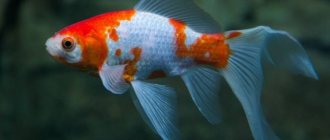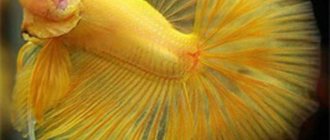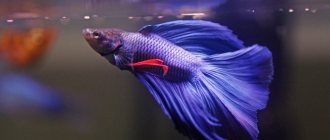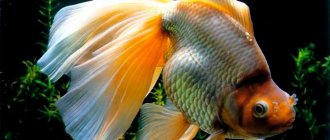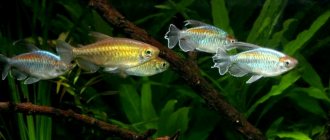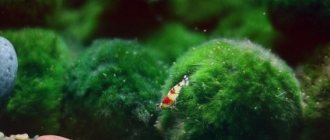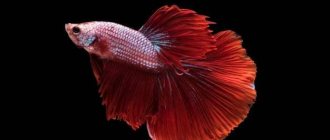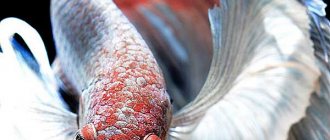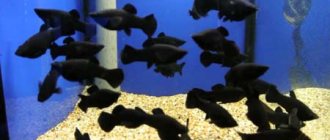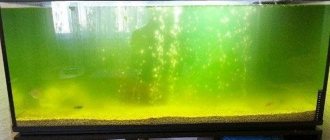When planning to breed bettas, be prepared for the fact that these are unique fish and need special attention. Their mating and spawning is a whole ritual, which is extremely interesting to watch. Of course, it is better if a professional handles the breeding of pets, but even a beginner can do the task. You just need to learn more about how to properly organize the process and raise offspring. You will learn about this and many other nuances from our article.
How to choose the right parents
When buying bettas, you should know for what purpose you are purchasing the fish and what results you want to achieve. Fish for selection are selected with special care, but the first available representatives are not suitable for home breeding either, because the viability of the fry depends on their condition.
To buy the right fish, purchase them only from trusted breeders. They will also help to acquire different-sex individuals, which at an early age the aquarist will not be able to distinguish on his own.
If you buy betta fish from a pet store, there is a good chance you will end up with old betta fish that are unable to reproduce. Also, if you buy pets for breeding in a store, you will not know anything about their pedigree. For a home aquarium this is not important, but if you want to do commercial breeding, this factor is important.
At home, select a pair of young, active and bright cockerels.
What to do next?
In order for the fry of these fighting fish to grow and become excellent representatives of their breed, care must be taken to create comfortable conditions for their development.
Recommendations for caring for betta fish at home:
- Feeding. Food for the fry should be prepared before they appear. In the first days, the menu welcomes the presence of brine shrimp, vinegar eels and ciliates. After a couple of weeks, tubifex is added to the daily diet, which is cut as finely as possible before feeding.
- Aquarium. The container in which it is planned to keep the fry must be equipped with a compressor. It is recommended to maintain the water temperature in the range from 22 to 24°. Since the temperature in the spawning area was 4-5° higher, then after the fry move to a new place, the temperature should drop gradually. It is necessary to refresh the water every day, replacing ¾ of the liquid of the total volume. 4-week-old fry are transplanted into a spacious aquarium.
- Life in a new aquarium. Until the moment when a small cockerel turns into a worthy representative of its breed, it can arouse increased interest among larger fish as food. Therefore, it is not recommended to transplant young specimens into an aquarium with pugnacious, overly active and predatory fish neighbors.
How to distinguish fish from each other
It is easy to distinguish a female from a male. Sex differences become visible when the fish reach the age of 3 months. It is advisable to select a male and female of the same size and color.
- the female has a round white spot on her belly that looks like an egg;
- males are much brighter than females, which are rather pale and faded;
- the fins of the “men” are much longer and brighter, those of the females are shorter and paler.
The male's fin determines his age: the longer and brighter it is, the more mature the male is. It is very difficult to determine the sex of fish younger than 10-11 weeks.
For breeding, take fish from 5-6 months, but not older than 1.5 years. This is important because adult males have various acquired body defects; their body is no longer so healthy. Fry from aged fish often die.
Aquarium fish Cockerel disease: symptoms and treatment
The aquarium fish Cockerel can get sick from several diseases. Here are the most common diseases:
- The main danger for cockerels is fin rot. Bettas can become infected with it from other fish; in addition, pathogenic microorganisms develop in food debris and in the soil. For treatment, baths with chloramphenicol or streptocide are used (or special products that can be bought in pet stores), and the aquarium is also disinfected and washed. A sign of this disease is ragged tail and fins;
- The ciliate ichthyophthirius causes semolina, or ichthyophthyriosis, when the fish becomes covered with lumps of semolina porridge. Treat with bicillin-5 and trypaflavin;
- exophthalmia, when the fish has bulging eyes, helps with magnesium sulfate and Ammonium-minus;
- dropsy is a serious disease that is difficult to treat. Here you need the help of a specialist. A sign is a bloated stomach;
- oodiniosis, or “Velveteen disease,” in which the fins stick together, is treated with antibacterial agents, and columnaria (“Mouth fungus”) is treated with baths of phenoxyethane.
We hope that this article was able to answer questions regarding keeping, feeding, the difference between a male and a female, types and diseases of the Cockerel aquarium fish.
How to properly prepare for spawning
2 weeks before spawning, the owner catches a suitable pair and places the partners in two separate aquariums. Some aquarists place containers with fish nearby: they believe that this way the cockerels will get used to the company faster. If pets begin to spread their fins and tail in front of each other, this indicates that they are interested in each other. If they show aggression, then the owner should choose another partner for the male.
We recommend reading
Fire barbs
You can do it differently: in the aquarium where the male is, place his girlfriend, who is in a small jar. This way the fish will get to know each other better. But this method cannot be used for a long time, since the female cannot constantly be in a tight space.
Diet for future parents
The fish are given live food for about 2 weeks. These can be worms, crickets, cockroaches, bloodworms, and brine shrimp. This diet will help the males get in good shape, and the females’ eggs will ripen faster. Food is given crushed and in the quantity that the fish can eat at one time.
Also, during preparation, the owner should start preparing food for future fry. Ciliates are grown. It's easy to do. You need to pass the water through a siphon and pour it into a two-liter jar. Next, add dry banana peel and 1 teaspoon of honey to the water. When the liquid in the jar brightens, it will be possible to see the ciliates in the water, gathered in clusters.
Spawning of cockerels
Then you put the male there - usually he immediately builds a nest. The next day we place the female with him. Attention - the female must be plump, with eggs. The fish are not fed in the spawning area! Usually after 3 - 24 hours, spawning begins, during the process the male “embraces” the female and “squeezes” the eggs out of her, simultaneously fertilizing her. Afterwards he releases the female, at this moment she is relaxed and practically goes to the bottom in the same position. The male is brightly colored, while the female, on the contrary, turns pale. In females of dark colors, dark longitudinal stripes may appear on the body. The male collects the falling eggs (they are sinking and white) into the nest and again “squeezes” the female, usually until there are no eggs left in her. Next, the female hides, as the male begins to drive her away from the nest, because the female can eat the eggs. But it also happens that the female helps the male collect eggs in the nest. After spawning, the female should be removed.
Cockerel fry
How to properly prepare a spawning tank
For spawning, you will need to take a container with a volume of 15-20 liters, fill it with water so that it does not reach 12-15 cm from the edge of the aquarium. If the vessel has a volume of 40 liters or more, then it is filled only 1/2 with water.
A small heater is placed in the container. It should heat the water to 26-27 degrees. There is no need to install a compressor and filter in the spawning tank.
To help the male build a nest faster, you can plant the aquarium with small-leaved floating algae. Riccia and pistia are used for this. Plants also serve as shelter for the female if the “daddy” becomes too annoying.
There should be no small stones or sand at the bottom of the aquarium. The eggs can easily get lost in such soil and die.
Preparation for mating games and possible problems
After 2 weeks of fattening, the male is planted in a prepared spawning area. If the color of the fish in the new container has become brighter, this indicates that they are completely ready for spawning.
The future dad is building a nest in the spawning area. He does this in a very interesting way. Captures bubbles from the surface of the water and quickly spits them out, thus forming foam. This is where the fry will develop. Many aquarists believe that the size of the nest indicates the male's sexual abilities, but this is not true. The size of the nest does not depend on anything and does not affect anything.
If the male begins to build, a pregnant female friend is placed next to him. Its readiness is easy to determine. The fish will have a dense, full belly; the stripes on the belly and the characteristic white speck will be greatly enlarged. If the male stops building a nest in the new aquarium and chases the female, divide the vessel into two parts with glass. Remove the glass during spawning.
We recommend reading
What to feed ancistrus: food for fry and adult catfish
If reproduction does not begin, increase the temperature of the water in the aquarium by 1-2 degrees and make it softer.
Description
In this publication we will talk about the most famous fighting fish species, Betta splendens. Aquarium betta fish (Betta splendens (Regan, 1909)) first came to the aquarium of hobbyists from Thailand, where they live in reservoirs poor in oxygen. They grow up to 6 cm, but usually smaller. Through selection, numerous color variations have been obtained, including almost all the colors of the rainbow.
Recently, unique shapes with different fin patterns have become very popular. Betta fish got their name from the pugnacity of the males. For this reason, it is almost impossible to keep several males in one aquarium. Aquarium betta fish belong to the labyrinth family.
Labyrinthine family (Anabantidae). Males are much brighter, often larger and slimmer than females. Usually the eggs are laid in a foam nest or float near the surface; less often, incubation occurs in the mouth of the male. The incubation period is 24-60 hours, after another 3-5 days the juveniles swim. Mostly peaceful, carnivorous fish.
How does reproduction occur?
The male begins to actively chase the female around the aquarium and strikes her. This is how he conveys his excitement to her. Moreover, the female never turns sideways to her partner, otherwise he will cause her serious injuries.
After some time, she shows the male her eggs. After this, he tries to snuggle closer to his partner. Pressing close, he puts pressure on his girlfriend's abdomen. Because of this, the eggs fall out of the female, and milk is released from the male. All this is connected and lowered to the bottom of the aquarium. The male carries the eggs to the built nest. Sometimes he even collects them at the bottom.
Such mating games can be repeated 2-3 times. The female produces about 600 eggs during one spawning. They are white and irregular in shape.
Actions after mating
After spawning is completed, the female must be caught from the container. The male, protecting the offspring, can injure her. It is advisable to transplant the mother into a separate aquarium and treat her body with a drug called MarOxy. It is also advisable to add the product to the aquarium where the eggs are located. It will help preserve offspring and neutralize the fungus.
It is not advisable to feed the parents in the spawning area: leftover food can worsen the water quality. It is possible to give food to the male after mating, but do not be alarmed if he does not eat everything right away. This phenomenon is normal. Remove any leftover food from the aquarium using a syringe.
A few days after the eggs appear, remove the male as well. At this time, the fry will already learn to swim calmly. After 2 weeks, the parents can begin spawning again.
How caviar develops
1 day after emergence, the eggs change greatly: their size increases sharply, they take on the shape of a ball. The male constantly repairs the collapsing nest and monitors the offspring.
After 2 days, larvae emerge from the eggs. This is a very difficult stage for the parent: the larvae begin to actively move and may fall to the bottom of the aquarium. The male constantly tries to bring them back. At this time, the fry do not look like real fish: they are small and have a yolk sac, which they need for nutrition.
If the males bred in a large aquarium, then the owner needs to catch the eggs and transplant them into a separate container filled with 12-15 cm of water.
After a day, the offspring leaves the nest. The cockerel tries to return them to their place, but the attempts do not yield results. At this time, the male becomes calmer, his coloring fades. He is removed from the kids and returned home. If after 1-2 days his condition has not returned to normal, the male is placed in a separate aquarium and the drug “MarOxy” is added.
Thus, the emerging egg becomes a fry in just 3 days.
General requirements
Reproduction of cockerels at home does not require special techniques or manipulations. Given the correct microclimate, temperature and balance of chemicals in the water, breeding this fish should not pose any particular difficulties.
However, you should not throw aside some points to ensure an ideal environment for the spawning of aquarium fish. Proper preparation of the aquarium is also very important. You will understand this with experience.
If you want to professionally breed these creatures, then you need to take into account the selection rules to obtain the desired offspring with a certain size, color and shape of fins. To do this, you need to form a pair correctly.
The most important thing is to choose the right pair
There should not be any particular difficulties in determining the sexual characteristics of betta fish. Sexual characteristics in fish appear at the age of 2-3 months. They begin to reproduce 2-3 months after the appearance of sexual characteristics. In the female, you can observe a peculiar thickening on the abdomen, which resembles an egg. Females have small fins and are not brightly colored. Males, on the contrary, attract attention with their bright colors and long fins.
The older the male is, the larger, brighter and more beautiful his fins are.
Fish of the same age, size and color are prepared for breeding. Aquarium fish that have reached six months of age are suitable for mating. Fish older than 1.5-2 years are not allowed for breeding. Old cockerels cannot reproduce healthy offspring. The eggs, as a rule, have damage to the shell; the fry are weak and often die after leaving the shell. Read more about this interesting species in this video:
For high-quality selection of cockerels, it is better to buy a pair at a specialized pet store or from professional breeders.
We begin to care for the offspring
After the fry have appeared, start feeding them ciliates. They are given to the fry in the first week after emergence.
We recommend reading
Maintenance and reproduction of handsome chromis
On days 3-4, the fry are fed Artemia nauplii.
To grow nauplii you will need to do the following:
- take a 2 liter jar;
- pour water into it, add 1.5 tablespoons of salt and 1.5 tablespoons of brine shrimp eggs;
- turn on strong aeration;
- after 1 day, turn it off, the required amount of nutritious food is ready;
- We remove the shells and collect the nauplii with a hose.
Artemia should not be overfed. This can lead to disturbances in the yolk sac.
After 3-4 days in the aquarium with babies, we reduce the water temperature. It should match the room one. If you give live food, then there is no need to change the temperature. Also, if you feed dry food, then 4/5 of the total volume of water in the aquarium needs to be changed every day.
Matching
When choosing a pair for breeding, you must first of all pay attention to the fact that the future parents are completely healthy, sexually mature and do not have any problems with the reproductive system. As already mentioned, sexual maturity in males occurs at the age of 3–4 months.
It is not recommended to choose fish for breeding that are more than 1–1.5 years old. Carefully examine the potential couple for diseases. Pay attention to these signs:
- scales peel off or fade;
- cloudy eyes;
- damaged fins;
- there are wounds on the body;
- no appetite;
- reduced physical activity.
You should not choose unhealthy individuals for breeding.
In addition, the anthropometric data of the future parents must match, because if the fish are too different in size, they will not be able to have offspring. Did you know? A male betta fish is depicted on the standard desktop wallpaper for the Windows 7 Beta operating system.
It is also extremely important that the female and male know and get used to each other well. To do this, they should live in the same aquarium for some time. However, due to the aggressive nature of male bettas and the potential danger of this behavior to the health and life of the female, most breeders recommend placing the fish on opposite sides in aquariums with a transparent partition.
Caring for grown young animals
After 2 weeks, the fish can eat microworms and microplankton. After another 7 days, finely chopped tubifex is given. This diet can be kept for up to 40 days. Giving food is required 2 times a day.
Also watch the amount of food you eat. If there are a lot of ciliates swimming in the aquarium, this indicates that the fry have a lot of food, the portions need to be reduced.
In addition, you can feed with liquid microfood. It is diluted with water taken from the aquarium. Do the same with egg yolk.
Only after 3 weeks will the fry develop a respiratory system. Before it forms, you need to place a compressor in the aquarium, but do not place a filter in the aquarium with fry. The fish cannot cope with the current yet and will end up inside the device.
At this stage of growth, the water level is increased slightly and half the liquid is changed every day. After 21 days, transplant the young animals into a container with a volume of at least 100 liters. After 3 months, you can determine the sex of the fish, and when they are 5-6 months old, you can start breeding males again.
Preparing starter feed for feeding fry
It is necessary to stock up on food at this stage, since it is better to feed the fry with live food. Since the fry of cockerels are small, they eat ciliates first. So, take a jar, preferably three liters, siphon the soil in your aquarium and pour this water into the jar - there are always ciliates in an old aquarium! Add some dead parts of plants, a teaspoon of milk, a 1 by 1 cm piece of dry banana peel and place the jar in a bright place. At first the water becomes cloudy, then it brightens and clouds of ciliates are visible even to the naked eye. It is convenient to select them using a hose from the compressor.
Female blue crown-tailed cockerel, with eggs
The dangers of lack of sexual activity
Female bettas, like many other female fish, collect eggs. And if, after its recruitment, the spawning period has not begun, then the eggs can transform into a cyst. The likelihood is especially high if you do not allow the fish to reproduce at all. It is impossible to remove such a cyst and the fish with it dies.
As a treatment, you can put such a fish on a diet and not give it food at all for several days. However, this method only works when the cyst has just appeared in the fish.
There is another way to help the fish if spawning pets is not part of your plans. Try expressing the eggs by holding the fish between your fingers and slowly pressing on the abdomen. True, this method is fraught with serious injuries, especially if the owner does not have experience.
The breeding frequency of betta fish is selected individually for each female. The minimum break between spawning periods is 2 weeks.
Share the article on social networks and like it if you learned everything you wanted from it. Don't forget to share your experience with other aquarists in the comments.
Dating and Spawning
Prepared fish need to be carefully introduced. You can use different aquariums for this. One fish is placed in each and placed side by side. After such adaptation, closer acquaintance occurs easier.
You can shorten the ritual by placing the female fish in the aquarium with the male. At first, they should be separated by a glass partition. When the male stops showing signs of aggression and begins to spread his fins and build a nest of bubbles, the septum must be carefully removed. After this, the interesting process of breeding the bettas in the spawning aquarium should begin.
It is better to introduce female and male bettas first in different aquariums placed side by side.
If the aggressive behavior does not go away, you can separate the couple for a while and then try to resume mating.
To build a nest, the male can add duckweed, pistia, or other small floating plant to the spawning area.
Betta spawning is like a fancy dance. The fish are circling around each other. The male grazes the female quite intensely. When the female gives a certain signal, the male helps her release eggs by wrapping himself around her and pressing on the abdomen. Then he collects the eggs in the nest.
The female is placed in another aquarium. Future fish remain in the care of their father.
